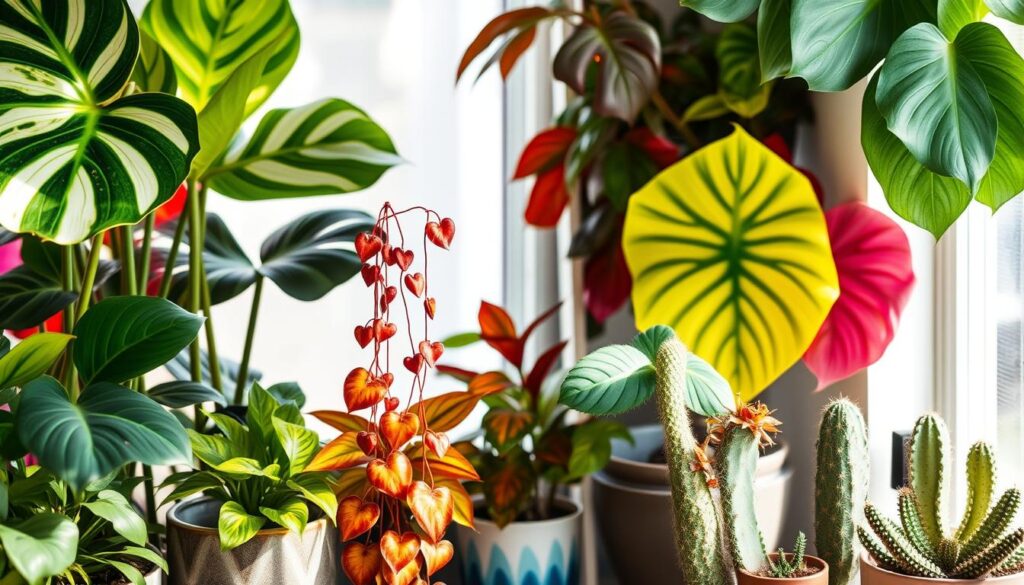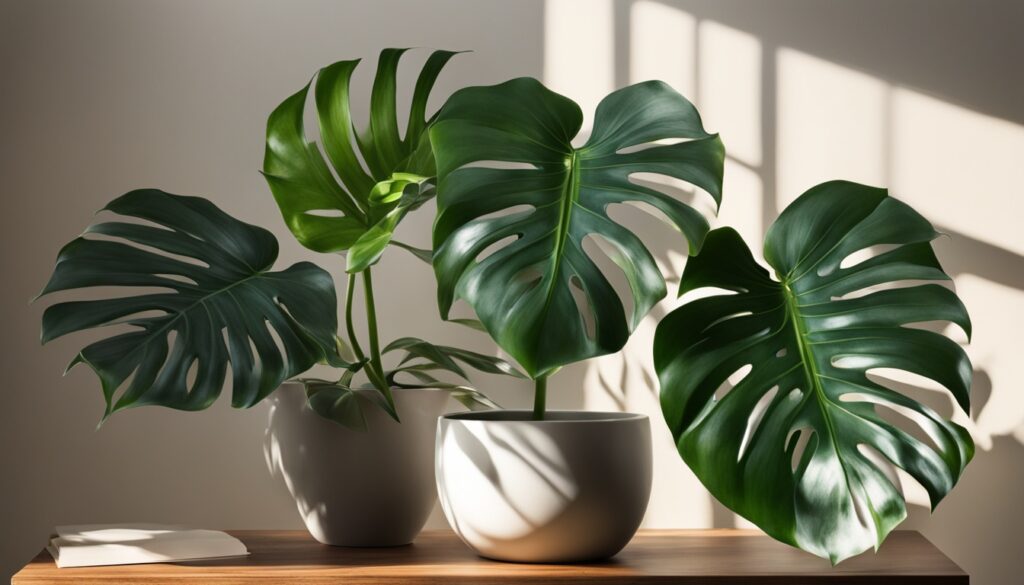Imagine your home filled with rare and exotic houseplants that catch everyone’s eye. Welcome to the world of unique indoor gardening. Here, you can find stunning plants from all over the world. Each one has its own story to share.
Rare houseplants often have special features like unique leaves or growth patterns. Many people collect these plants to add interest and beauty to their homes. Whether you’re new to plants or have been growing them for years, there’s always something new to discover.
Key Takeaways
- Explore a world of rare and unique house plant varieties from diverse environments
- Discover captivating plants with unusual features, growth habits, and limited natural habitats
- Add intrigue, visual interest, and a touch of the exotic to your indoor spaces
- Embark on an exciting journey of plant collecting and cultivation
- Uncover the fascinating stories behind these rare and remarkable houseplants
Introduction to Rare Indoor Plant Collecting
Indoor gardening is fascinating, especially when you collect rare plants. These plants are hard to find and make your home a botanical paradise. Whether you’re new or experienced, finding rare plants is a rewarding adventure.
Understanding Rare Plant Classifications
Rare plants are grouped by how rare they are, their unique features, or how hard they are to find. They might only grow in certain places or have special looks. Learning about these classifications helps you find plants that match your taste.
Benefits of Collecting Unique Specimens
Collecting rare plants brings many joys. It lets you create a space that shows off your style and love for nature. Watching these plants grow is exciting, and they might even become more valuable over time.
When you start collecting rare plants, choose ethical sources. Good suppliers can teach you how to care for these plants. This keeps them healthy and beautiful for years.
| Rare Plant Species | Approximate Cost | Unique Features |
|---|---|---|
| Saxifraga stolonifera ‘Nezu Jinja’ | £7 | Distinctive rosette-forming leaves and delicate white flowers |
| Aroid Varieties | Hundreds of pounds | Diverse foliage patterns, unique growth habits, and vibrant colors |
| Pilea peperomioides | £3-£5 | Once a rare and sought-after plant, now more widely available |
By exploring rare indoor plant collecting, you can turn your home into a lush oasis. It becomes a place that shows off your unique style and love for nature.
Exploring Exotic Houseplant Varieties
The world of exotic houseplants is full of unique and sustainable foliage. These plants can turn any indoor space into a stunning work of art. From the vibrant pink hues of Philodendrons to the intricate patterns of Croton Iceton, they are a feast for the senses.
The Epipremnum aureum ‘N’Joy’, or N’Joy Devil’s Ivy, has striking green and white leaves. It adds elegance to any room. The Philodendron ‘Prince of Orange’ changes color from copper-orange to deep green, creating a mesmerizing display.
Succulent lovers will enjoy the Crassula ovata, or Jade/Money plant. It has thick, fleshy leaves for a unique texture. The Aglaonema ‘Pictum’ Tricolor, or Chinese Evergreen, has vibrant pink, green, and white hues that grab attention.
| Exotic Houseplant Variety | Unique Characteristics |
|---|---|
| Epipremnum aureum ‘N’Joy’ | Striking green and white variegated leaves |
| Philodendron ‘Prince of Orange’ | Foliage that transitions from copper-orange to deep green |
| Crassula ovata (Jade/Money plant) | Thick, fleshy leaves with a unique texture |
| Aglaonema ‘Pictum’ Tricolor (Chinese Evergreen) | Vibrant pink, green, and white hues in the foliage |
These exotic houseplants and many others offer endless possibilities for indoor gardens. They let plant enthusiasts create stunning spaces that inspire and delight.
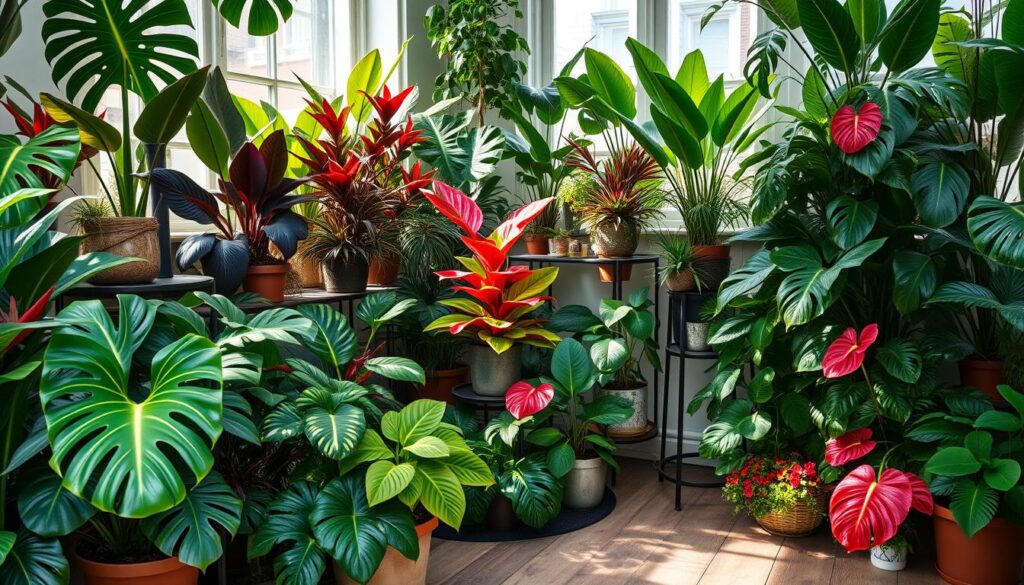
“Rare and unique houseplants are like living art, adding unexpected pops of color and texture to our indoor spaces.”
Essential Care Tips for Rare Plant Species
Caring for rare houseplants needs a careful eye for their needs. Knowing about temperature, humidity, watering, and lighting is key. This ensures your rare plants stay healthy and vibrant. Follow these tips to make your indoor garden flourish.
Temperature and Humidity Requirements
Most rare plants like temperatures between 65°F and 85°F. Tropical plants, like Philodendron Splendid, need warm, humid places. They often need mist or pebble trays for moisture. Desert plants, like cacti, prefer dry air and lower humidity.
Watering and Fertilization Guidelines
Watering rare plants should be careful. They can easily get root rot. Let the soil dry a bit before watering again. Use warm water and avoid too much moisture. Fertilize during the growing season, but use less than common plants.
Light Requirements for Exotic Plants
Lighting needs differ for rare plants. Some, like the Blue Star Fern, do well in low light. Others, like the Fiddle Leaf Fig, need bright, indirect light. The Spek-tacular Cast Iron Plant can handle various light levels. Research each plant’s light needs for the best care.
Understanding rare plants’ needs helps create a lush indoor oasis. Regularly check your plants and adjust care as needed. Buy from trusted suppliers for a rewarding gardening journey.
“The secret to successfully growing rare houseplants lies in paying attention to their individual needs and providing the ideal growing environment.”
Unique House Plant Varieties for Beginners
If you’re new to indoor gardening, there are many low-maintenance plants to try. These plants add beauty and calm to your home.
The Euphorbia Trigona, or African Milk Plant, is a great choice. It has striking stems and can handle different light levels. The Bromeliad Cupcake is also unique, with its colorful bracts that look like a cupcake.
The Rhaphidophora tetrasperma, or Monstera Minima, is perfect for small spaces. It loves low light and needs little care.
For more options, consider the Crassula ovata, or Jade Plant, and some Prayer Plant varieties. They have interesting leaves and patterns. Plus, they’re easy to care for, making them great for beginners.
| Plant Variety | Growth Habit | Lighting Needs | Watering Requirements | Humidity Preferences |
|---|---|---|---|---|
| Euphorbia Trigona (African Milk Plant) | Upright, succulent-like | Bright, indirect light | Water every 2-3 weeks | Average household humidity |
| Bromeliad Cupcake | Compact, rosette-forming | Partial to full shade | Water every 1-2 weeks | Moderate to high humidity |
| Rhaphidophora tetrasperma (Monstera Minima) | Trailing, vining | Bright, indirect light | Water every 1-2 weeks | Average household humidity |
| Crassula ovata (Jade Plant) | Upright, succulent | Bright, indirect light | Water every 2-3 weeks | Average household humidity |
| Maranta leuconeura (Prayer Plant) | Spreading, low-growing | Partial shade | Water every 1-2 weeks | Moderate to high humidity |
These plants are perfect for beginners in indoor gardening. They’re easy to care for and add beauty to your space. They can turn your home into a lush, low-maintenance greenery oasis.
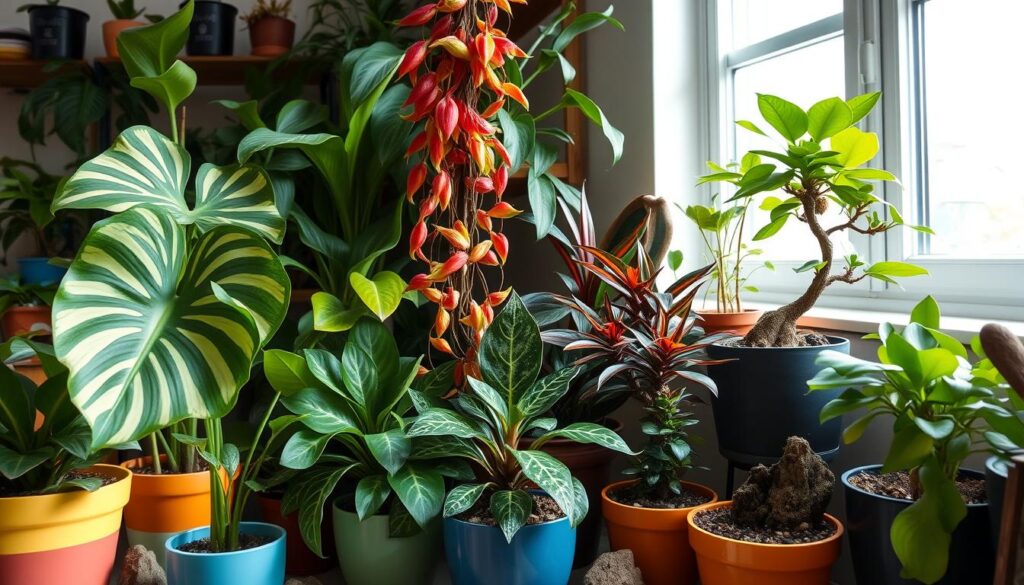
Tropical Rarities: From Rainforest to Living Room
Explore the world of tropical rarities that turn your living space into a lush oasis. These exotic houseplants come from the green rainforests. Each one brings a unique beauty and connects you to nature’s wonders.
Philodendron Varieties
Philodendrons stand out with their bright leaves and interesting growth. The Philodendron verrucosum ‘Incensi’ and the Philodendron melanochrysum are favorites. They love bright, indirect light and add a tropical feel to any room.
Exotic Alocasia Species
Alocasia is known for its stunning leaves and growth. The Alocasia ‘Heterophylla’ and the Alocasia ‘Platinum’ have vibrant leaves. They need careful care but are worth it for their rainforest feel.
Bringing these tropical rarities into your home connects you to nature. They turn your space into a lush oasis. Enjoy growing these exotic houseplants and feel like you’re in the rainforest, right in your living room plants.
Variegated Plants: Nature’s Living Art
In the world of indoor plants, variegated plants are all the rage. They have leaves with cool color patterns, like green, white, yellow, and pink. The Epipremnum aureum ‘N’Joy’ and the Ficus elastica ‘Moonshine Schriveriana’ are just a few examples. They’re loved by both plant lovers and interior designers.
Variegated plants are beautiful because they look like they were painted by nature. Each leaf is a work of art. The Spathiphyllum ‘Diamond’ (Variegated Peace Lily) is a great example. It has green leaves and white flowers, making it stand out.
“Variegated plants are the true gems of the botanical world, offering a glimpse into the endless possibilities of natural patterns and colors.”
It’s fun to grow variegated plants, whether you’re new or experienced. You can use leaf propagation to get more of these plants. This way, you can bring nature’s beauty into your home.
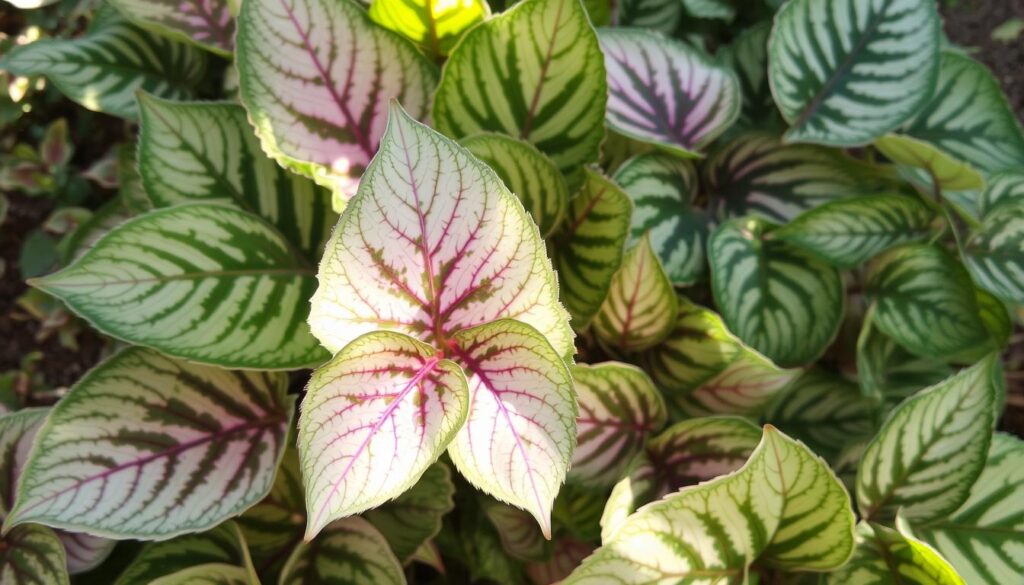
As more people want unique plants, variegated ones are becoming very popular. They can be the main attraction in a room or part of a carefully chosen decor. These plants are sure to amaze and inspire everyone who sees them.
Low-Maintenance Rare Plant Options
In the world of rare houseplants, there’s a special group that stands out. These sustainable foliage options need little care. They’re perfect for those who love unique house plant specimens but don’t want to spend a lot of time on them. Let’s look at some drought-resistant and desert-adapted plants that are great for low-maintenance greenery.
Desert Varieties
Plants from the desert, like Euphorbia ingens ‘Variegata’ and Kalanchoe orgyalis (Copper spoons), love dry conditions. They’re tough and can handle neglect, making them perfect for beginners or those short on time.
Drought-Resistant Specimens
- Crassula ‘Buddha’s Temple’: This small succulent has unique leaves that need little water and can go long without it.
- Sansevieria (Snake Plant): These plants are very hardy. Varieties like ‘Moonshine’ can do well in many places with little water.
- Haworthia cuspidata: These small succulents have beautiful rosettes. They’re easy to care for and add beauty to any collection.
Choosing these low-maintenance greenery options lets plant lovers enjoy unique house plant varieties without the hassle. They need little care and can grow well in many conditions. These sustainable foliage choices are a great start for anyone new to rare plants.
“Rare plants are the gems of the botanical world, and with the right care, they can thrive even in the most humble of homes.”
Creating the Perfect Environment for Rare Plants
To grow rare and exotic houseplants, you need to know their needs. This includes light, humidity, temperature, and air circulation. By adjusting your indoor garden, you can make a space where these plants thrive.
Lighting Requirements
Rare tropical plants love bright, indirect light. Place them near windows that get filtered sunlight. For darker spots, use high-quality grow lights to help them grow well.
Humidity and Airflow
Many rare plants come from humid places. So, keeping the air moist is key. Use a humidifier or pebble trays to add moisture. Also, make sure air moves well to prevent fungal diseases. Fans or open windows can help with this.
Temperature Regulation
These plants prefer temperatures between 65°F and 80°F (18°C to 27°C). Avoid sudden changes in temperature. Keep their environment stable and comfortable.
Soil and Watering
Use soil that drains well to prevent waterlogging. Mixes with perlite, orchid bark, and peat moss work great. Water them right, keeping the soil moist but not too wet. Adjust your watering based on the plant and the season.
By understanding what rare houseplants need, you can create a beautiful botanical home decor. With the right indoor gardening and plant care tips, your rare plants will thrive. They’ll add a unique touch to your home.
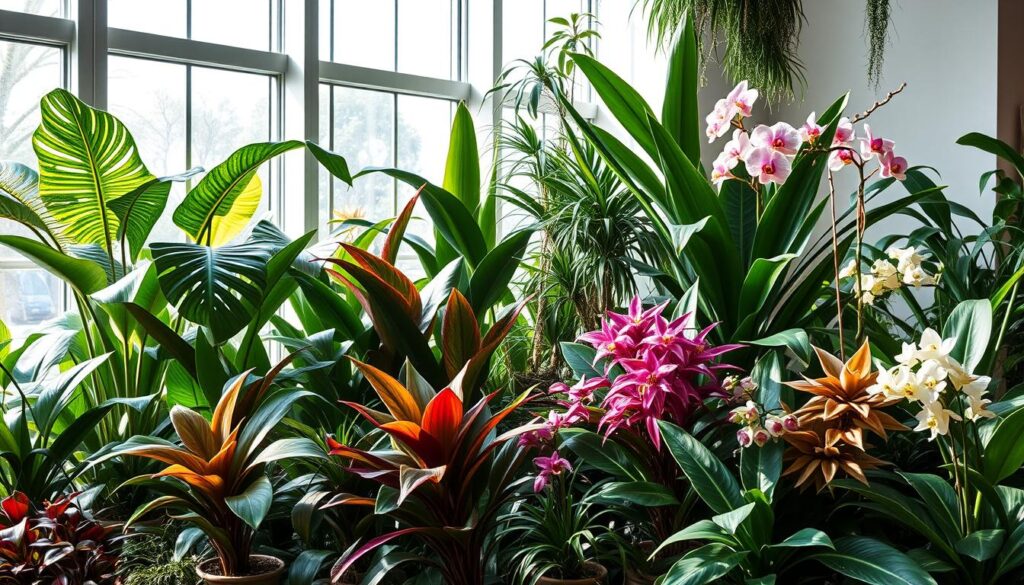
Investment-Worthy Collector’s Plants
In the world of indoor gardening, some plants are true treasures. They are rare, beautiful, and can increase in value. These plants are loved by many and offer a fun journey in rare plant varieties and unique house plants.
Market Trends
The demand for rare plants is growing fast. More people want unique and beautiful plants for their homes. Plants like the Philodendron ‘Pink Princess’ and Monstera deliciosa ‘Albo Variegata’ are very popular. Their prices show how much people want them.
Value Appreciation Factors
The value of these plants comes from several things. Rarity, how hard they are to grow, and how they look are key. Some plants can cost a lot, like the Monstera Adansonii Variegata, which sold for $38,000. The white variegated Rhaphidophora Tetrasperma sold for $27,000 in New Zealand.
| Plant Variety | Price Range |
|---|---|
| Philodendron ‘Pink Princess’ | $100 – $1,000+ |
| Monstera deliciosa ‘Albo Variegata’ | $200+ |
| Alocasia Azlanii | $100 – $700 |
| Anthurium Crystallinum | $100 – $200 |
| Monstera Adansonii Variegata | $38,000 |
| Rhaphidophora Tetrasperma (White Variegated) | $27,000 |
These rare plants are a great chance for collectors and enthusiasts. They can make indoor gardening exciting and potentially very rewarding.
“The most expensive houseplant ever sold was a Monstera Adansonii Variegata that fetched $38,000.”
Sourcing and Purchasing Rare Plant Varieties
Plant lovers and collectors find joy in finding house plant varieties that are rare and exotic houseplants. Whether you’re experienced or new, finding rare plant varieties makes your indoor garden special and interesting.
Happy Houseplants is a top place to find unique house plant species. They have a wide range of hard-to-find plants. For example, the Syngonium Aurea Arrowhead has soft green and creamy white leaves. The Alternanthera ‘Dentata’ Purple Houseplant has rich purple and burgundy leaves.
- Syngonium Aurea Arrowhead: Soft green and creamy white arrowhead-shaped leaves
- Alternanthera ‘Dentata’ Purple Houseplant: Rich purple and burgundy leaves
- Syngonium Milk Confetti: Soft green and creamy white speckled leaves
- Dieffenbachia ‘Cheetah’ Purple Houseplant: Rich green and striking creamy-white variegated leaves
- Philodendron Paraiso Variegata: Heart-shaped leaves with rich green and creamy-white variegation, fragrant star-shaped blooms
- Hoya Callistophylla: Lance-shaped leaves with forest green and silver variegation
When buying rare plant varieties, check the plant’s health and how it’s shipped. Happy Houseplants makes sure their plants are healthy and shipped carefully. This helps prevent damage during shipping.
Be careful of plants that seem too cheap. They might be unhealthy or not what they seem. Also, know the rules for bringing exotic houseplants into your country.

Working with trusted nurseries and following ethical practices lets plant lovers discover amazing plants. They can add beautiful unique house plant specimens to their collections.
Common Challenges in Rare Plant Care
Caring for rare house plants is rewarding but comes with challenges. Pests and diseases are common issues. Knowing how to handle these problems is key to keeping your plants healthy.
Pest Management
It’s important to check your plants for pests often. Look for signs like webbing, discolored leaves, or sticky spots. These could mean spider mites, mealybugs, or scale insects are present.
Neem oil and insecticidal soaps are good, plant-friendly ways to get rid of pests. They help keep your sustainable foliage safe.
Disease Prevention
Stopping diseases is crucial for rare plants. Overwatering, bad air flow, and dirty tools can spread infections. Quarantine new plants and keep tools clean to prevent disease.
By being careful and proactive, you can keep your rare plants healthy. This ensures they thrive in your indoor gardening space.
| Pest | Susceptible Plants | Treatment |
|---|---|---|
| Mealybugs | Orchids, African Violets, Begonia, Coleus, succulents, amaryllis, Hoyas | Neem oil, insecticidal soap |
| Spider Mites | Wide range of house plants | Neem oil, insecticidal soap |
| Scale Insects | Variety of tropical and succulent plants | Horticultural oil, insecticidal soap |
“The rare plant market has evolved into a million-dollar industry, showcasing the growing demand and interest in unique, sustainable foliage for indoor gardening enthusiasts.”
Propagation Techniques for Rare Species
Exploring indoor gardening often leads to rare and unique plants. These plants are a joy to grow but can be tricky to propagate. Yet, with the right methods, anyone can grow their collection.
Stem cuttings are a common way to propagate indoor plants. They work well for plants like pothos, philodendrons, and ivy. Leaf cuttings are best for African violets, snake plants, and begonias. For plants with many stems, like peace lilies and spider plants, division is a good choice.
Some plants, like bromeliads and aloe vera, grow offsets that can be used to start new plants. The time it takes for plants to root can vary. Using plastic bags or pebble trays can help speed up the process.
| Propagation Method | Suitable Plant Varieties |
|---|---|
| Stem Cuttings | Pothos, Philodendrons, Ivy |
| Leaf Cuttings | African Violets, Snake Plants, Begonias |
| Division | Peace Lilies, Spider Plants, Ferns |
| Offsets | Bromeliads, Aloe Vera |
When growing rare plants, it’s crucial to learn the specific propagation methods for each. Cuttings do best in light, fluffy soil. Be patient, as each plant has its own rooting time. Getting advice from experts can help you succeed in growing your unique plants.
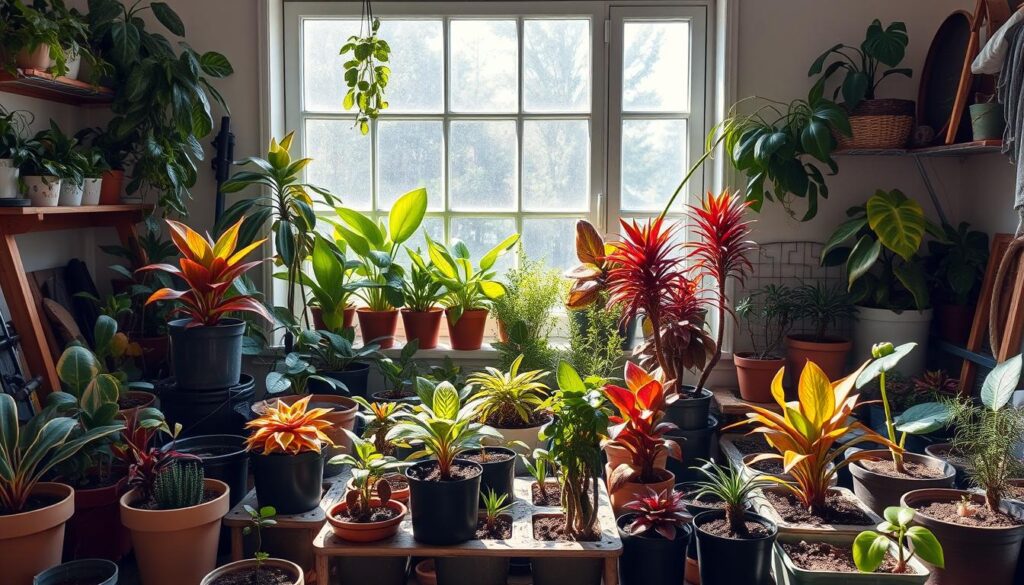
Seasonal Care Adjustments for Exotic Plants
As seasons change, so does your unique house plant care. It’s important to adjust to temperature, light, and humidity changes. This ensures your exotic plants stay healthy and vibrant all year.
In winter, many tropical plants slow down. They need less water and fertilizer to avoid problems. Cut back on watering by 25-30% and dilute fertilizers by 50%. Keep temperatures between 65-85°F and add extra light for the darker days.
When spring and summer arrive, start watering and lighting more. It’s best to repot during these active seasons. Watch out for pests and diseases, as changing conditions can make plants more susceptible.
By understanding your plants’ needs and making seasonal changes, you can create a perfect environment. With a bit of care, your indoor gardening space will be a joy to behold all year.
| Seasonal Adjustment | Winter | Spring/Summer |
|---|---|---|
| Watering | Reduce by 25-30% | Increase to match growth cycle |
| Fertilizing | Dilute by 50% or avoid | Resume regular feeding |
| Lighting | Supplement with grow lights | Increase light exposure |
| Temperature | Maintain 65-85°F | Adjust to optimal range |
| Repotting | Avoid | Best time for transplanting |
“Adjusting your care routine to the seasons is key to keeping exotic plants thriving. With a little seasonal TLC, your indoor oasis will continue to delight year-round.”
Conclusion
Collecting and caring for rare house plants is a rewarding hobby for indoor gardening fans. There are many rare plant varieties to choose from, each with its own needs. These exotic houseplants can add beauty and character to your home if cared for properly.
The world of rare house plants is always changing, offering new discoveries. Whether you’re new or experienced, growing these plants is a joy. It shows the beauty of nature. By caring for these plants, you can create a special indoor space that shows off the plant kingdom’s diversity.
Keep exploring the world of rare and exotic house plants. Stay curious, patient, and dedicated. With the right care, these plants can thrive in your home. Let your love for unique house plant collecting grow as you care for your plants.
